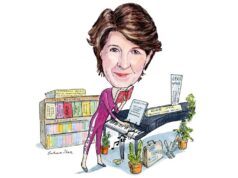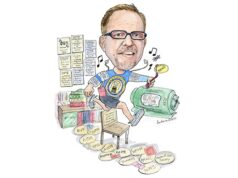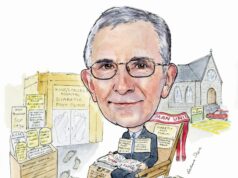 Growing up in Kenya, Stéphan Haulon’s early experience of the medical profession came in the form of the “flying doctors”, who piloted small planes to remote areas to care for patients. Combined with his post-medical school experience providing humanitarian relief in post-genocide Rwanda, Haulon’s introduction to a medical career was anything but routine. Haulon spoke to Vascular News about how his training—including a particularly formative period at Cleveland Clinic with Roy Greenberg—provided the foundation of a career built alongside cutting-edge technology, patient-specific treatment, and “thinking outside of the box”.
Growing up in Kenya, Stéphan Haulon’s early experience of the medical profession came in the form of the “flying doctors”, who piloted small planes to remote areas to care for patients. Combined with his post-medical school experience providing humanitarian relief in post-genocide Rwanda, Haulon’s introduction to a medical career was anything but routine. Haulon spoke to Vascular News about how his training—including a particularly formative period at Cleveland Clinic with Roy Greenberg—provided the foundation of a career built alongside cutting-edge technology, patient-specific treatment, and “thinking outside of the box”.
Why did you decide you wanted a career in medicine, and why in particular did you choose to enter the vascular field?
I was raised in Nairobi, Kenya, in Eastern Africa. I was very impressed by the “flying doctors” working there; they would fly and land their small planes anywhere to take care of sick people alone, or to transfer them to city hospitals. These were my heroes as a child. I always wanted to become one of them. When I graduated from medical school, and just before starting my vascular training, I had the opportunity to go back to Africa with “Médecins du Monde”, a French humanitarian volunteer organisation, with whom I spent a month in Kigali, Rwanda, just after the 1994 summer genocide. This is really why I decided to be a doctor, and if my work is now far from humanitarian practice, I will be involved with it again at the end of my career.
When I was a general surgery resident, I started with an OB-GYN rotation and then moved to vascular surgery. The various approaches, from the neck to the lower limbs, including the chest and the abdomen, were of great interest as a young surgeon. The ability to collaborate with other surgical specialties, such as urology, cardiothoracic surgery, etc. was very stimulating and I learned a lot from these multidisciplinary approaches. Ultimately, during my second rotation in vascular surgery, I was exposed to initial experiences with endovascular aneurysm repair (EVAR).
The head of vascular and cardiothoracic surgery at that time, Pr Czelas Stankowiak, was a pioneer and a visionary, and performed the first EVAR procedure in Lille in 1996. I was instantly enthusiastic about this revolutionary approach, despite most of my young and also experienced colleagues considering this procedure a “non-surgical approach” with no future. During the rest of my residency, I learned a lot from my interventional radiology colleagues (another winning multidisciplinary collaboration).
Finally, vascular patients are mostly polyatheromatous patients, who require a global treatment strategy and not only a surgical repair. Early and long-term outcomes are highly dependent on that multidisciplinary medical and surgical path of care, involving vascular medicine and cardiology. All these collaborations, and the infancy of a breaking technology, made my choice to enter vascular surgery obvious. I have never regretted it! I was far from visualising what was going to happen next…
Who have been your most important career mentors and what wisdom did they impart?
My mentor and best friend was Roy K Greenberg. On top of teaching me everything I know about complex aortic endovascular repairs, he taught me to “think outside of the box!” and to understand the physics and haemodynamics of the aorta, and how to build an aortic and a research programme. From this transatlantic training experience, funded by the European Society for Vascular Surgery (ESVS) and Society for Vascular Surgery (SVS) Marco Polo Grant, I realised that those currently in training should be prepared to engage in global training and that trainers should be prepared to provide it. Roy was an unbelievably talented endovascular practitioner, a gifted inventor and developer, caring for his patients, meticulous in his documentation, hard-working and humble, a great team leader and teacher, an inspirational speaker, and had the ability to look at a problem differently than others. He was, above all, a fantastic friend; to harmonise with someone at work is a joy, to harmonise at work and play is something very special.
He has trained many other leaders in the field, all close friends, including Tara Mastracci, Gustavo Oderich, Tim Resch, and Andy Schanzer, who also consider Roy a model mentor.
Although they were not my mentors per definition, I was fortunate to meet and spend time with other pioneers in the field who were also eager to share their experience and enthusiasm: David Hartley, Michael Laurence Brown, and John Anderson from down under; and Krassi Ivancev and Tim Chuter from Malmö and San Francisco.
My open surgery mentor was Mohamad Koussa, a remarkable open cardiovascular surgeon; in addition to teaching me open surgery, he was a great supporter in the development of my endovascular thoracoabdominal and arch practice.
I also want to acknowledge those who helped me with my local, national and international academic career: Professors Branchereau, Ricco, Prat and Warembourg.
What has been the biggest development(s) in vascular medicine during the course of your career?
The endovascular revolution started when I was a resident. Since then, vascular surgery has been collaborating with endograft and imaging companies to push the boundaries of this minimally invasive approach that was first proposed to patients who were not candidates for an open repair, and, once evaluated, to a larger range of patients. We are now treating arch and thoracoabdominal aneurysms and dissections without the need for a sternotomy or a thoracophrenolombotomy approach. There are still a lot of developments required to simplify these very challenging procedures and to improve early and late outcomes, but we have to acknowledge the immense impact that the endovascular era has had on our practice. I want to make it crystal clear that I am not promoting the endovascular over the open repair approach; the modern vascular surgeon must be trained and an expert with both techniques, they will prefer one or the other, or perform both at the same time, depending on the location of the vascular disease and the patient’s physiology. That is what makes the vascular surgeon unique; no one else has such comprehensive skills.
What is the most interesting paper or presentation that you have seen recently?
I am currently very impressed by all the developments in augmented reality and artificial intelligence. This will be the upcoming revolution, after the endovascular one. We are currently underestimating the impact that this will have on our daily practice. There are so many resources and so much brainpower dedicated to the development of these new tools that we will soon enter a new cycle: be prepared!
Three-dimensional (3D) printing will also have an impact in our field, for simulation and training. In the near future, 3D printers will almost instantly build devices tailored to the patient’s anatomy; we are thus rapidly moving towards personalised medicine.
What are your current research interests?
I am focusing on imaging applications that will reduce exposure to radiation, having in mind that our young colleagues will perform 80% of their practice exposed to X-rays. I am developing a new generation of branched and fenestrated endografts, and dedicated bridging stents. I have learned so much from working with engineers from the imaging and endovascular device companies, and in the biomaterial lab. Again, the multidisciplinary approach is key for success.
When choosing between off-the-shelf, custom-made and chimney endografts for complex EVAR procedures, how do you decide which approach to take?
My preferred option to treat a complex aneurysm is a custom-made endograft. I believe that an endograft specifically tailored to the patient’s anatomy will have the best long-term outcome, and this is really what matters. Most techniques report favourable early or mid-term outcomes, but what we are really aiming for is long-term outcomes, after five-year follow-up. In acute cases, in patients not candidate for an open repair, we currently have no other option than to implant an off-the-shelf endograft, the only available being the t-branch (Cook Medical). I consider chimneys only as bailout procedures, but I have to acknowledge that I have a bias; I have been “spoiled”, ever since I have finished my training in 2003, as I have always had access to custom-made devices. This is, unfortunately, not the case for most of my colleagues.
Do you think that we will ever be able to move to an endovascular-first approach to ascending aorta/arch repair?
Yes, we are getting there. My experience with endovascular repair of the arch shows that a subgroup of patients may highly benefit from such a procedure. These are the patients with prior ascending repair, mostly in the setting of an acute type A dissection. The proximal sealing zone is then in a prosthetic tube graft, which can be considered as an ideal sealing zone. Some case series report favourable outcomes following ascending aorta endografting, but we currently do not have mature technology to propose an endovascular-first approach to type A dissections or Bentall procedures. Having said that, who would have believed in the mid-90s that we would be performing endovascular repairs of arch aneurysms 15 years later? It is thus just a matter of time.
How can new advanced imaging applications assist endograft implantation planning? What are the next steps in development for these technologies?
These new imaging applications will guide you through the procedure. Nowadays, you can design a fusion mask that will include all but only the information that is required to perform the procedure, record the best working positions for each step of the procedure and recall them from table side, and assess technical success at the end of the procedure with 3D imaging. It results in shorter procedures, less exposure to radiation, reduced volume of contrast injection, higher technical success rates and fewer early secondary procedures. The next steps are the availability of these applications for everyone on cloud-based platforms, integration of non-X-ray sources such as ultrasound and electromagnetic fields, and augmented reality.
Could you tell us about one of your most memorable cases? What did this experience teach you?
This case could have ended up as my worst nightmare. In a patient with an arch aneurysm, following implantation of an ascending endograft, I advanced the delivery system of an arch branched endograft. A conflict between the delivery system and the ascending endograft resulted in forward migration towards the aortic valve of the ascending endograft, and immediate haemodynamic instability. The branched component was rapidly deployed as planned to remove the delivery system from the aortic valve and provide supra aortic trunk perfusion. Aortography showed (fortunately) that the coronary arteries were patent but severe aortic regurgitation was present. The strut of the proximal bare metal stent of the ascending endograft was obstructing the aortic valve, and this was confirmed by transoesophageal echocardiography which showed no movement of the left coronary cusp. An emergency transcatheter aortic valve replacement procedure was performed resulting in immediate haemodynamic improvement. Because this case had been discussed and planned during our weekly aortic multidisciplinary meeting involving anaesthesiology, cardiology and cardiac surgical colleagues, everyone was already informed and concerned about that case, and thus rapidly efficient in treating this life-threatening complication. Alone, I would not have been able to fix it. It is mandatory to have a team approach and to seek other colleagues’ expertise.
What are some of the proudest moments in your career?
I am very proud when young colleagues that I have trained get an academic appointment. Recently I was very honoured and privileged to be elected ESVS president for 2019–2020. The European Society is very active, includes all countries throughout Europe, and non-European councillors are now joining (India) in conjunction very strong links to some large non-European communities that are created. I am very proud to be part of this vision of a society open to others, having so many concerns on how politicians around the world are working in the opposite direction.
My proudest moment was when I was asked to give the first Roy Greenberg Distinguished Lecture at the 2013 SVS Annual Meeting in San Francisco, under the presidency of Peter Gloviczki. This was a very particular event, because Roy, my mentor, had chosen me for that lecture, which has a very special significance. In addition, he was not able to attend the Annual Meeting, but I knew he was listening to my lecture. It was for me a great opportunity to share my experience from training with a pioneer, the phenomenon Roy K Greenberg!
What three questions in vascular medicine still need to be answered?
- Which acute type B dissections require aortic endografting in addition to best medical treatment?
- When should surgery be performed in asymptomatic carotid stenosis?
- What is the best endovascular approach to peripheral artery occlusive disease?
In addition:
- How can we make newly-approved technology available for everyone?
- How can we perform endovascular repairs without being exposed to radiation?
What advice would you give to young vascular surgeons starting out in their careers?
That they should be prepared to engage in global training; it is of paramount importance to be exposed to many different approaches to treat vascular patients. Training has to include both open and endovascular techniques; this is what makes our specialty so special. And never forget the advice that I got from my mentor: think outside of the box! It is not because one technique has been performed for decades that it is the ultimate technique to treat the disease. Learn from the other specialties and stay tuned to new technology. Finally, be obsessed about radiation protection.
What are some of your hobbies and interests outside of medicine?
The Alps! I spend most of my free time over there, hiking and mountaineering during summer, and downhill and country skiing during winter. I enjoy travelling around the planet with my family, visiting new cities, museums (especially contemporary art), and meeting people. Another is rugby—I used to play and now I watch it! I am originally from the Basque country, in the south west of France, where rugby is a religion! Finally, like any Frenchman, I enjoy good food and wine.
Fact File
Current roles
Professor of Vascular Surgery, chairman of Aortic and Vascular Surgery, Hôpital Marie Lannelongue, Université Paris Sud, Le Plessis Robinson, France
Undergraduate and postgraduate education
2003 European Board of Vascular Surgery
2002 PhD in Biomaterials, Lille University, Lille, France
2001 Board Certification in Vascular surgery (France)
2000 Board Certification in General surgery (France)
1999 Medical Thesis, Lille University, Lille, France
1997 Master of Science degree in Biomaterials, Paris University, Paris, France
1988–1994 Medical School, University Hospital Broussais, Paris University, Paris, France
Postgraduate appointments
2018 Professor of Vascular Surgery, Paris Sud University, Paris, France
2017 Consultant Vascular Surgeon, Hôpital Marie Lannelongue, Paris, France
2008 Consultant Vascular Surgeon, King’s College Hospital, London, UK
2006 Professor of Vascular Surgery, Lille University Hospital, Lille, France
2003 Consultant Vascular Surgeon, Lille University Hospital, Lille France
2002–2003 Vascular Surgery Research Fellow, The Cleveland Clinic Foundation, Cleveland, USA, under the supervision of Roy K Greenberg
2000–2002 Vascular Surgery Clinical Fellow, Department of Vascular Surgery, Lille University Hospital, Lille, France
1994–2000 General and Vascular Surgery Resident, Lille University Hospital, Lille, France













